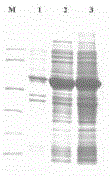Recombinant nuclease and preparation method thereof
A technology of recombinant nucleic acid and exonuclease, applied in the biological field, can solve the problem of product inactivity, achieve high expression, simple expression scheme, and improve quality
- Summary
- Abstract
- Description
- Claims
- Application Information
AI Technical Summary
Problems solved by technology
Method used
Image
Examples
Embodiment 1
[0066] Example 1 Obtaining of Recombinant Nuclease Gene
[0067] According to the nuclease gene sequence of S. marcescens (S. marcescens) reported in the literature (GenBank: M19495.1), the gene expression sequence was optimized. The optimized sequence is shown in Sequence Table 1, and 20 complementary oligonucleotides were synthesized. According to the conventional method of molecular cloning, first treat with T4 bacteriophage polynucleotide kinase at 37°C for 30min. The phosphorylated oligonucleotide fragments are mixed in equal moles, denatured at 94°C for 5min, immediately annealed at 65°C for 10min, and then added T4 ligase Ligated overnight at 16°C to obtain the target gene template fragment. Take 4 sterilized microcentrifuge tubes and add:
[0068]
[0069] The above mixture was shaken gently and then centrifuged briefly, and then placed in a water bath at 14°C for incubation and connection overnight (12-16h). Take 5μl of the ligation product and add it to 50μl of E. coli ...
Embodiment 2
[0070] Example 2 Expression of N-terminal fusion tag recombinant nuclease gene
[0071] Design a pair of primers, primers 1 and 2, see sequence 2 and sequence 3 in the sequence table respectively. The 5'end primer of the gene has an Nde I restriction site, and the 3'end primer has a BamH I restriction site. In 0.2ml PCR Prepare 25μl reaction system in a microcentrifuge tube:
[0072]
[0073] Pre-denaturation at 94°C for 5 minutes, setting 94°C for 1 minute, 55°C for 1 minute, 72°C for 2 minutes, 30 cycles in total, and finally 72°C for 10 minutes. After PCR, 10μl of the product was taken and subjected to agarose gel electrophoresis. The size of the fragment was consistent with the designed size of 777bp. See sequence 4 in the sequence listing, and the encoded amino acid sequence see sequence 5 in the sequence listing.
[0074] The pET-22a plasmid was digested with Nde I and BamH I to recover large fragments, and ligated with PCR nuclease gene fragments. The ratio of 20μL reaction s...
Embodiment 3
[0077] Example 3 Expression of C-terminal fusion tag recombinant nuclease gene
[0078] Design a pair of primers, primers 3 and 4 are shown in sequence 6 and sequence 7, respectively. The 5'end primer of the gene has an Nde I restriction site, and the 3'end primer has a BamH I restriction site. In 0.2ml PCR Prepare 25μl reaction system in a microcentrifuge tube:
[0079]
[0080] Pre-denaturation at 94°C for 5 minutes, setting 94°C for 1 minute, 56°C for 1 minute, 72°C for 2 minutes, 30 cycles in total, and finally 72°C for 10 minutes. After PCR, 10μl of the product was taken and subjected to agarose gel electrophoresis. The size of the fragment was consistent with the designed size of 784bp. See sequence 8 in the sequence listing, and the encoded amino acid sequence see sequence 9 in the sequence listing.
[0081] The pET-11b plasmid was digested with Nde I and BamH I to recover large fragments, and ligated with PCR nuclease gene fragments. The ratio of 20μL reaction system gene fr...
PUM
 Login to View More
Login to View More Abstract
Description
Claims
Application Information
 Login to View More
Login to View More - R&D
- Intellectual Property
- Life Sciences
- Materials
- Tech Scout
- Unparalleled Data Quality
- Higher Quality Content
- 60% Fewer Hallucinations
Browse by: Latest US Patents, China's latest patents, Technical Efficacy Thesaurus, Application Domain, Technology Topic, Popular Technical Reports.
© 2025 PatSnap. All rights reserved.Legal|Privacy policy|Modern Slavery Act Transparency Statement|Sitemap|About US| Contact US: help@patsnap.com



